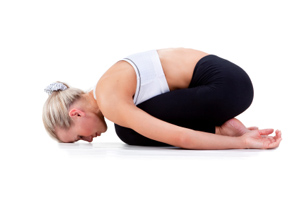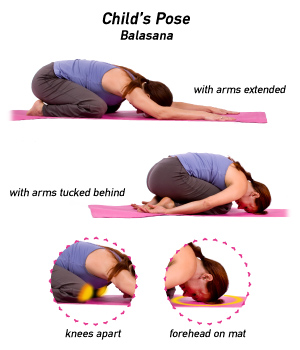How to Do Child's Pose in Yoga
 Child's Pose — Balasana (bah-LAHS-uh-nuh) — is a common beginner's yoga pose. It is often used as a resting position in between more difficult poses during a yoga practice. The word "Balasana" comes from the Sanskrit words "bala" (meaning "child") and "asana" (meaning "pose").
Child's Pose — Balasana (bah-LAHS-uh-nuh) — is a common beginner's yoga pose. It is often used as a resting position in between more difficult poses during a yoga practice. The word "Balasana" comes from the Sanskrit words "bala" (meaning "child") and "asana" (meaning "pose").
Benefits of Child's Pose
Child's Pose helps to stretch the hips, thighs, and ankles while reducing stress and fatigue. It gently relaxes the muscles on the front of the body while softly and passively stretching the muscles of the back torso.
This resting pose centers, calms, and soothes the brain, making it a therapeutic posture for relieving stress. When performed with the head and torso supported, it can also help relieve back and neck pain. Sometimes used as a counter-pose to backbends, Child's Pose restores balance and equanimity to the body.
Life is the period between one breath and the next; the person who only half breathes, only half lives. He who breathes correctly acquires control of the whole being.
Regular practice of Child's Pose also teaches conscious exploration of the breath. As the front of the body releases onto the thighs, the frontal ribs and abdominal muscles become slightly compressed. This restriction allows for a deeper opening of the back of the torso as the lungs expand behind the body. As this happens, keeping the breath slow, long, and steady allows for a new awareness of the breath's path through the front and back of the body.
Cautions
Do not practice Child's Pose if you have a current or recent knee injury. Women who are pregnant should only practice a wide-legged variation of the pose — do not press the belly on top of the thighs.
Always work within your own range of limits and abilities. If you have any medical concerns, talk with your doctor before practicing yoga.
Instructions

- Begin on your hands and knees. Center your breath, and begin to let your thoughts slow down. Turn your awareness inward.
- Spread your knees wide apart while keeping your big toes touching. Rest your buttocks on your heels.
- Those with very tight hips can keep their knees and thighs together.
- Sit up straight and lengthen your spine up through the crown of your head.
- On an exhalation, bow forward, draping your torso between your thighs. Your heart and chest should rest between or on top of your thighs. Allow your forehead to come to the floor.
- Keep your arms long and extended, palms facing down. Press back slightly with your hands to keep your buttocks in contact with your heels. Lengthen from your hips to your armpits, and then extend even further through your fingertips.
- For deeper relaxation, bring your arms back to rest alongside your thighs with your palms facing up. Completely relax your elbows.
- Let your upper back broaden. Soften and relax your lower back. Allow all tension in your shoulders, arms, and neck to drain away.
- Keep your gaze drawn inward with your eyes closed.
- Hold for up to a minute or longer, breathing softly.
- To release the pose, gently use your hands to walk your torso upright to sit back on your heels.
Modifications & Variations
Since Child's Pose is a resting position, it's important to make whatever modifications you need to feel comfortable, safe, and supported in the pose. Here are a few suggestions:
- If you have difficulty resting your buttocks on your heels, place a thickly folded blanket between the backs of your thighs and your calves.
- Spreading the knees wider apart can create a deeper stretch in the hips. Only spread your knees as wide as is comfortable for you — do not strain or force your body to extend deeper in this pose.
- Pad the tops of your feet with a blanket. You can also fold your mat for extra padding under your feet.
- Rest your forehead on a firm pillow, bolster, or stack of blankets. Alternatively, you can make fists and stack your hands, then rest your forehead on your stacked fists.
- Keeping your arms extended opens the shoulders and chest, but doing so makes the pose a bit more active. For a more restorative pose, rest your arms alongside your thighs.
Tips
Use Child's Pose throughout your practice whenever you need a break between poses or if you get out of breath. Return to the practice when you are ready.
Breathe consciously and fully into the back of your torso. Imagine your back is doming toward the ceiling, allowing the spine to lengthen and widen. With each exhalation, release your front torso a little deeper into the pose.
Relax & Let Go
Child's Pose is a simple way to calm your mind, slow your breath, and restore a feeling of peace and safety. Practicing the pose before bedtime can help to release the worries of the day. Practicing in the morning can you help transition from sleeping to waking. Regularly integrating Child's Pose into your practice will create serenity and overall well-being both on and off the mat.

